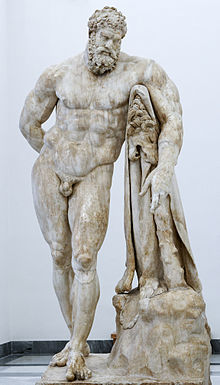
The Farnese Hercules is an ancient statue of Hercules, probably an enlarged copy made in the early third century AD and signed by Glykon, who is otherwise unknown; he was an Athenian but he may have worked in Rome. Like many other Ancient Roman sculptures it is a copy or version of a much older Greek original that was well known, in this case a bronze by Lysippos that would have been made in the fourth century BC. This original survived for over 1500 years until it was melted down by Crusaders in 1205 during the Sack of Constantinople. The enlarged copy was made for the Baths of Caracalla in Rome, where the statue was recovered in 1546, and is now in the Museo Archeologico Nazionale in Naples. The heroically-scaled Hercules is one of the most famous sculptures of antiquity, and has fixed the image of the mythic hero in the European imagination.

The Villa of the Papyri was an ancient Roman villa in Herculaneum, in what is now Ercolano, southern Italy. It is named after its unique library of papyri scrolls, discovered in 1750. The Villa was considered to be one of the most luxurious houses in all of Herculaneum and in the Roman world. Its luxury is shown by its exquisite architecture and by the large number of outstanding works of art discovered, including frescoes, bronzes and marble sculpture which constitute the largest collection of Greek and Roman sculptures ever discovered in a single context.

The Farnese Bull, formerly in the Farnese collection in Rome, is a massive Roman elaborated copy of a Hellenistic sculpture. It is the largest single sculpture yet recovered from antiquity. Along with the rest of the Farnese antiquities, it has been since 1826 in the collection of the Museo Archeologico Nazionale Napoli in Naples, inv. no. 6002, though in recent years sometimes displayed at the Museo di Capodimonte across the city. The sculpture in Naples is much restored, and includes around the base a child, a dog, and other animals not apparently in the original composition, which is known from versions in other media.

The Doryphoros of Polykleitos is one of the best known Greek sculptures of Classical antiquity, depicting a solidly built, muscular, standing warrior, originally bearing a spear balanced on his left shoulder. Rendered somewhat above life-size, the lost bronze original of the work would have been cast circa 440 BC, but it is today known only from later marble copies. The work nonetheless forms an important early example of both Classical Greek contrapposto and classical realism; as such, the iconic Doryphoros proved highly influential elsewhere in ancient art.

The Secret Museum or Secret Cabinet in Naples is the collection of 1st-century Roman erotic art found in Pompeii and Herculaneum, now held in separate galleries at the National Archaeological Museum in Naples, the former Museo Borbonico. The term "cabinet" is used in reference to the "cabinet of curiosities" - i.e. any well-presented collection of objects to admire and study.

Museo di Capodimonte is an art museum located in the Palace of Capodimonte, a grand Bourbon palazzo in Naples, Italy designed by Giovanni Antonio Medrano. The museum is the prime repository of Neapolitan painting and decorative art, with several important works from other Italian schools of painting, and some important ancient Roman sculptures. It is one of the largest museums in Italy. The museum was inaugurated in 1957.
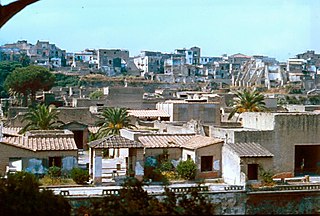
Ercolano is a town and comune in the Metropolitan City of Naples, Campania of Southern Italy. It lies at the western foot of Mount Vesuvius, on the Bay of Naples, just southeast of the city of Naples. The medieval town of Resina was built on the volcanic material left by the eruption of Vesuvius that destroyed the ancient city of Herculaneum, from which the present name is derived. Ercolano is a resort and the starting point for excursions to the excavations of Herculaneum and for the ascent of Vesuvius by bus. The town also manufactures leather goods, buttons, glass, and Lacryma Christi wine.

The House of the Faun, constructed in the 2nd century BC during the Samnite period, was a grand Hellenistic palace that was framed by peristyle in Pompeii, Italy. The historical significance in this impressive estate is found in the many great pieces of art that were well preserved from the ash of the eruption of Mount Vesuvius in 79 AD. It is one of the most luxurious aristocratic houses from the Roman Republic, and reflects this period better than most archaeological evidence found even in Rome itself.
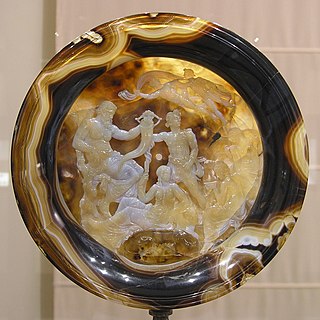
The Farnese Cup or Tazza Farnese is a 2nd-century BC cameo hardstone carving bowl or cup made in Hellenistic Egypt in four-layered sardonyx agate, now in the Naples National Archaeological Museum It is a 20 cm wide and similar in form to a Greek phiale or Roman patera, with no foot. It features relief carvings on both its exterior and interior surfaces and is around twenty centimeters in diameter.

The Antinous Farnese is a marble sculptural representation of Antinous that was sculpted between 130 and 137 CE. Antinous was the lover to Roman Emperor Hadrian; the emperor who, after Antinous's death, perpetuated the image of Antinous as a Roman god within the Roman empire. This sculpture is a part of the Roman Imperial style and was sculpted during a revival of Greek culture, initiated by Hadrian's philhellenism. Its found spot and provenance are unknown, but this sculpture is currently a part of the Farnese Collection in the Naples National Archaeological Museum.

The Biblioteca Nazionale Vittorio Emanuele III is a national library of Italy. It occupies the eastern wing of the 18th-century Palazzo Reale in Naples, at 1 Piazza del Plebiscito, and has entrances from piazza Trieste e Trento. It is funded and organised by the Direzione Generale per i Beni Librari and the Ministero per i Beni e le Attività Culturali.

Stabiae was an ancient city situated near the modern town of Castellammare di Stabia and approximately 4.5 km southwest of Pompeii. Like Pompeii, and being only 16 km (9.9 mi) from Mount Vesuvius, this seaside resort was largely buried by tephra ash in 79 AD eruption of Mount Vesuvius, in this case at a shallower depth of up to 5 m.
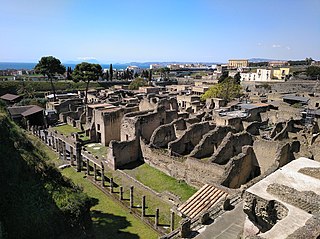
Herculaneum was an ancient Roman town, located in the modern-day comune of Ercolano, Campania, Italy. Herculaneum was buried under volcanic ash and pumice in the Eruption of Mount Vesuvius in 79 AD.
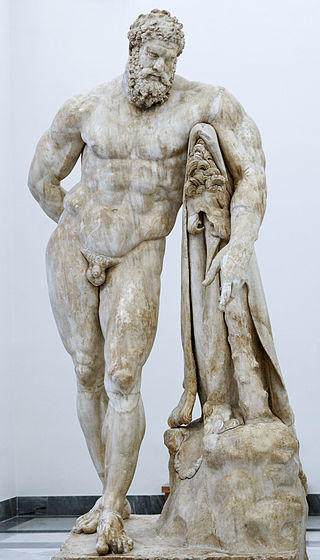
The classical sculptures in the Farnese Collection, one aspect of this large art collection, are one of the first collections of artistic items from Greco-Roman antiquity. It includes some of the most influential classical works, including the sculptures that were part of the Farnese Marbles, their collection of statuary, which includes world-famous works like the Farnese Hercules, Farnese Cup, Farnese Bull and the Farnese Atlas. These statues are now displayed in the Naples National Archaeological Museum in Italy with some in the British Museum in London.

In ancient Rome, a tintinnabulum was a wind chime or assemblage of bells. A tintinnabulum often took the form of a bronze ithyphallic figure or of a fascinum, a magico-religious phallus thought to ward off the evil eye and bring good fortune and prosperity.
A menologium rusticum, also known by other names, was a publicly displayed month-by-month inscription of the Roman calendar with notes on the farming activities appropriate for each part of the year. Two versions were recovered in Rome during the Italian Renaissance, the Menologium Rusticum Colotianum and the Menologium Rusticum Vallense. The first is now held by the Naples Museum and the second has been lost. Both of the known examples of the style appear to copy a separate original, include a sundial for tracking the hours of the day, and prominently display astrological information for each month. The original was probably carved sometime during the 1st century. In addition to these pillar-style menologia, the name is also sometimes applied to fasti and other wall calendars that include similar agricultural details in their coverage of the year.
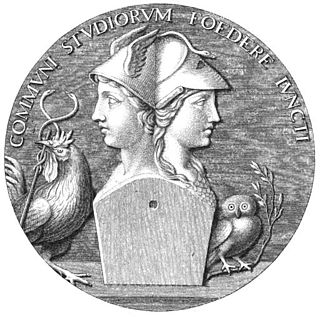
Hermathena or Hermathene was a composite statue, or rather a herm, which may have been a terminal bust or a Janus-like bust, representing the Greek gods Hermes and Athena, or their Roman counterparts Mercury and Minerva.

The National Archaeological Museum is a museum located right on Piazza San Marco in Venice.

Portrait of Pope Paul III with Camauro is a 1545 – 1546 oil on canvas painting by Titian, now in the Museo nazionale di Capodimonte in Naples.


